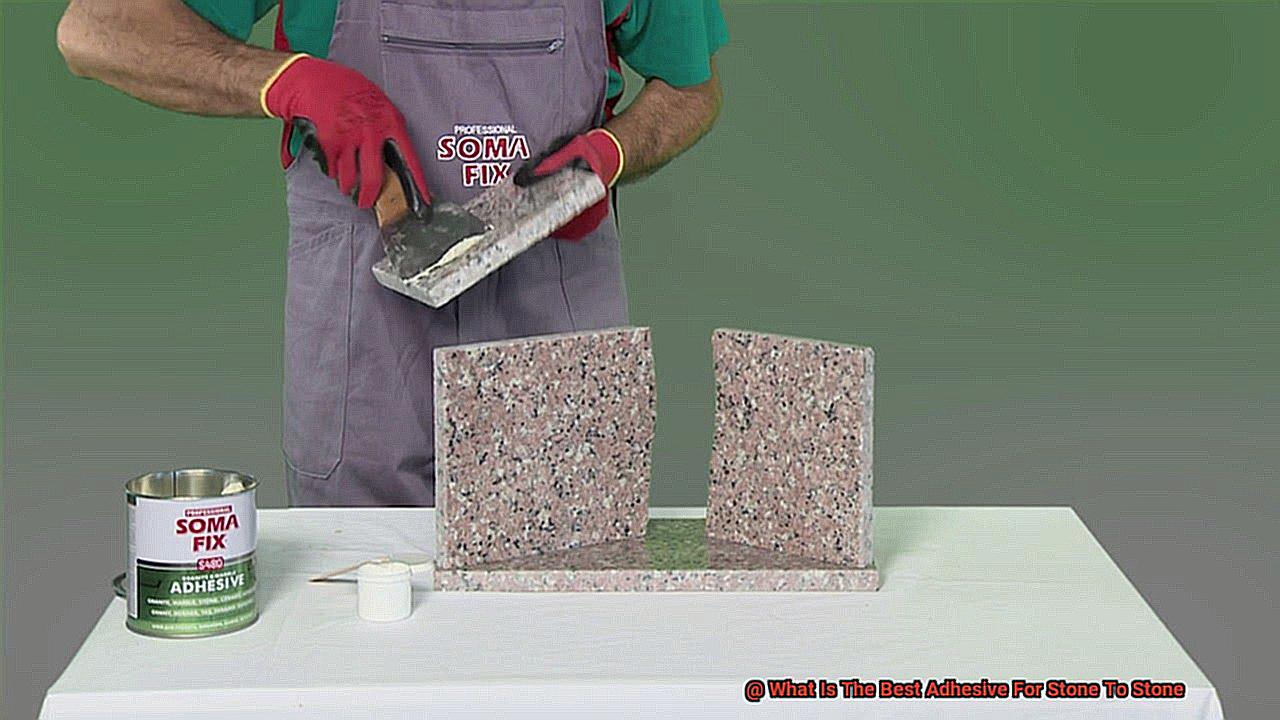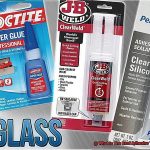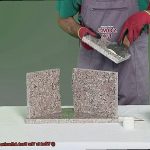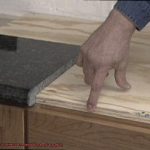There’s something enchanting, almost otherworldly, about the timeless beauty of stones. Whether it’s the majestic allure of towering marble monuments or the rustic charm of river rocks, these ancient wonders have captivated humans for centuries. But what happens when you want to bring these magnificent pieces together? That’s where stone-to-stone adhesives step in – the unsung heroes behind every seamless connection.
In a world where every bond is put to the test, finding the perfect adhesive for stone-to-stone cohesion can feel like an uphill battle. The stakes are high because a weak bond can lead to disastrous consequences, both structurally and aesthetically. But fret not. We stand at the edge, armed with secrets that unlock the strongest possible connection.
However, choosing the best adhesive for stone-to-stone applications is no walk in the park. From granite to limestone, each type of stone presents unique challenges that demand a tailored adhesive solution. In this guide, we’ll dive into the world of adhesives and grasp their strengths and weaknesses so you can make an informed decision.
Get ready for a comprehensive exploration of today’s arsenal of adhesives. From traditional mortars to modern epoxy resins, we’ll uncover their composition, application techniques, and durability. Brace yourself as we unveil the optimal bonding solution for your stone project – whether it’s an architectural marvel or a DIY masterpiece.
So whether you’re a seasoned construction professional or a passionate artisan, let us be your guide as we reveal the secrets behind finding the perfect adhesive for stone-to-stone bonding. Together, we’ll unearth the transformative powers of these remarkable adhesives and unleash true magic by amalgamating stones into eternity’s depths.
Types of Adhesives for Bonding Stone to Stone
Contents
- 1 Types of Adhesives for Bonding Stone to Stone
- 2 Special Considerations for Certain Stones
- 3 Preparing the Surfaces Before Applying the Adhesive
- 4 Selecting the Right Amount of Adhesive to Use
- 5 Securing the Bonded Stones in Place Until the Adhesive Cures
- 6 The Benefits of Using Epoxy-Based Adhesives for Bonding Stone to Stone
- 7 The Benefits of Using Polyurethane Adhesives for Bonding Stone to Stone
- 8 The Benefits of Using Silicone-Based Adhesives for Bonding Stone to Stone
- 9 Conclusion
In the realm of stone bonding, the choice of adhesive is a make-or-break decision. To ensure the stones stay securely in place despite the constant onslaught of moisture, temperature fluctuations, and vibrations, it is crucial to select an adhesive that offers both strength and durability. In this blog post, we will delve into the fascinating world of adhesives commonly used for bonding stone to stone, exploring their unique advantages and disadvantages.
Polyurethane Adhesive: Flexibility Unleashed
For those seeking flexibility in their stone bonding endeavors, polyurethane adhesives offer a tantalizing solution. With excellent flexibility that accommodates slight movements or vibrations between bonded stones, these adhesives shine in outdoor settings where heavy loads or foot traffic may be present. They exhibit impressive resistance to impact and shock while maintaining good resistance against water and weathering. Nonetheless, it is important to note that polyurethane adhesives may not provide the same level of sheer strength as epoxy adhesives.
Silicone Adhesive: Embracing Flexibility with Grace
In the realm of stone bonding that requires flexibility or joint sealing between stones, silicone adhesives stand tall. With remarkable resistance against UV rays, moisture, and temperature variations, silicone adhesives are a perfect fit for both indoor and outdoor applications. These adhesives form a robust bond while allowing for some movement without succumbing to cracks or loss of adhesive properties. However, it is worth mentioning that silicone adhesives may not offer the same level of sheer strength as epoxy or polyurethane adhesives.

Construction Adhesive: Might in Versatility
Harnessing the power of polyurethane-based or hybrid polymer-based formulations, construction adhesives emerge as a formidable option for bonding stone to stone. Boasting exceptional bonding strength and remarkable versatility, these adhesives can successfully bond an array of materials, including stone, concrete, wood, and metal. Their ease of use is a testament to their user-friendly nature, while their enduring bond stands tall against heavy loads and environmental factors.
Cementitious Adhesive: The Art of Porous Bonding
Cement-based adhesives, fondly known as thin-set or mortar adhesives, find their niche in bonding natural stone tiles or veneers to substrates.
Epoxy-Based Adhesives
When it comes to bonding stone to stone, you need an adhesive that can withstand the test of time. Enter epoxy-based adhesives – the superheroes of bonding materials. With their exceptional strength, durability, and resistance to environmental factors, these adhesives create an unbreakable bond that can handle any challenge. In this article, we’ll delve into the advantages of using epoxy-based adhesives for stone-to-stone bonding, unraveling their versatility and resilience. So grab your hard hat and join us on this fascinating journey.
Versatility at Its Finest:
Epoxy-based adhesives are the ultimate chameleons of the adhesive world. They possess the remarkable ability to bond different types of stones together seamlessly. Granite, marble, slate, quartzite – it doesn’t matter. These adhesives thrive in the face of diversity and are capable of tackling any stone type with ease. Say goodbye to compatibility issues – epoxy-based adhesives offer versatility at its finest.
Strength That Can Take the Weight:
Building structures with stone requires an adhesive that can bear heavy loads and stresses without buckling under pressure. Enter epoxy-based adhesives, the unsung heroes of strength. With their outstanding bonding strength, these adhesives stand tall and firm even when faced with the heaviest stone slabs. Gaps and voids between stone surfaces? No match for epoxy-based adhesives. They effortlessly fill these imperfections, ensuring a tight and secure bond that can withstand anything nature throws their way.

A Battle Against Nature:
Mother Nature may be fierce, but epoxy-based adhesives are ready to go head-to-head with her forces. Their excellent resistance to water, chemicals, and temperature fluctuations makes them ideal for both indoor and outdoor applications. Whether you’re working in a humid bathroom or creating an outdoor masterpiece exposed to the elements, epoxy-based adhesives will hold their ground against moisture and varying climatic conditions. You can rest easy knowing your stone-to-stone bond is fortified against nature’s wrath.
Polyurethane Adhesives
These extraordinary adhesives possess a range of exceptional qualities that make them an ideal choice for creating strong and durable bonds between stones. Let’s explore the remarkable benefits and considerations of using polyurethane adhesives for your stone applications.
First and foremost, polyurethane adhesives are renowned for their unmatched strength and durability. When you need a bond that can withstand even the toughest challenges, these adhesives rise to the occasion, ensuring your stones stay firmly in place.
But their superpowers don’t end there – polyurethane adhesives are also incredibly versatile. They have the incredible ability to bond a wide range of materials, including different types of stones. Regardless of variations in texture or composition, these adhesives confidently create secure bonds that stand the test of time.
When it comes to weather resistance, polyurethane adhesives are unbeatable. They exhibit excellent resistance to moisture and weathering, making them suitable for both indoor and outdoor applications. Rain or shine, these adhesives won’t let environmental factors compromise the integrity of your stone structures.
Flexibility is another standout feature of polyurethane adhesives. Unlike some other adhesives that become brittle over time, these adhesives retain their flexibility even after curing. This remarkable characteristic allows them to absorb vibrations and movement without compromising the bond. This means you can trust polyurethane adhesives to keep your stones secure, even in earthquake-prone areas.
But wait, there’s more. These adhesives possess exceptional gap-filling properties. They effortlessly fill in small gaps and irregularities between stones, ensuring a tight and seamless bond. This quality proves particularly advantageous when working with uneven or irregularly shaped stones, as it enhances both the structural integrity and aesthetic appeal of your stone creations.
While polyurethane adhesives offer an array of impressive benefits, it’s important to consider a few factors. Proper surface preparation is crucial, as these adhesives require clean surfaces free from dirt, oil, or loose particles for optimal bonding. Additionally, the curing time for polyurethane adhesives may be slightly longer compared to other adhesives. However, exercising patience throughout the bonding process will reward you with a resilient and long-lasting bond.
Silicone-Based Adhesives
Prepare to be amazed by the superhero of adhesives – silicone-based adhesives. These remarkable bonding agents have taken the world by storm, offering unbeatable strength, flexibility, and reliability when it comes to bonding stone to stone. Let’s dive deeper into the incredible world of silicone-based adhesives and discover why they are the ultimate choice for creating unbreakable bonds.
The secret to the power of silicone-based adhesives lies in their composition. These adhesives are a combination of a silicone polymer and various additives such as fillers, thickeners, and cross-linking agents. This unique blend forms an adhesive that can withstand even the most challenging situations.
Durability is a key feature of silicone-based adhesives. They can brave harsh environmental conditions like temperature fluctuations, moisture, and UV exposure without losing their grip. Rain or shine, these adhesives stand strong. They are resistant to water and chemicals, making them ideal for both indoor and outdoor applications.
Flexibility is another remarkable trait of silicone-based adhesives. Like a skilled contortionist, they can absorb vibrations and movements without cracking or breaking the bond. So whether your stones experience constant vibrations or occasional shifts, silicone-based adhesives will keep them firmly in place.
Silicone-based adhesives come in various forms to suit different needs. Whether you’re looking for caulks, sealants, or adhesives, there’s a silicone-based option for every application. From filling gaps between stones to sealing edges, these versatile adhesives have got you covered.
Proper surface preparation is crucial when working with silicone-based adhesives. Before applying the adhesive, ensure that your stone surfaces are clean and free from dust, dirt, grease, or any other contaminants. Enhancing the adhesive’s adhesion can be achieved by using a primer or surface treatment. Remember, a strong and long-lasting bond starts with meticulous preparation.
Curing time is an essential factor to consider when using silicone-based adhesives. Depending on the product and environmental conditions, the curing time can vary. It is vital to follow the manufacturer’s instructions regarding curing time and handling of the bonded materials. Patience is key to ensuring a bond that stands the test of time.
Special Considerations for Certain Stones
In the world of stone bonding, not all stones are created equal. Each type possesses unique properties that require special considerations when selecting the perfect adhesive. In this article, we will delve into the fascinating realm of stone adhesion and explore the various factors to keep in mind when working with different types of stones.
Porous Stones:
Imagine stones like limestone or sandstone, with their high absorption capacity, eagerly soaking up moisture and other liquids. To create a lasting bond with these porous stones, it is imperative to choose an adhesive specifically formulated for such materials. These adhesives penetrate deep into the stone’s pores, forging a robust and unyielding connection. Look for low viscosity adhesives that seep effortlessly into the very essence of the stone.
Marble and Granite:
The allure of marble and granite lies in their durability and aesthetic appeal. However, their smooth and non-porous surfaces can pose a challenge when it comes to bonding. Enter epoxy-based adhesives, the saviors of marble and granite bonding. With their exceptional bonding strength, even on non-porous surfaces, epoxy adhesives provide the answer. Furthermore, their extended curing time allows for precise alignment and adjustment before the adhesive sets, ensuring a flawless bond.
Heat Resistance:
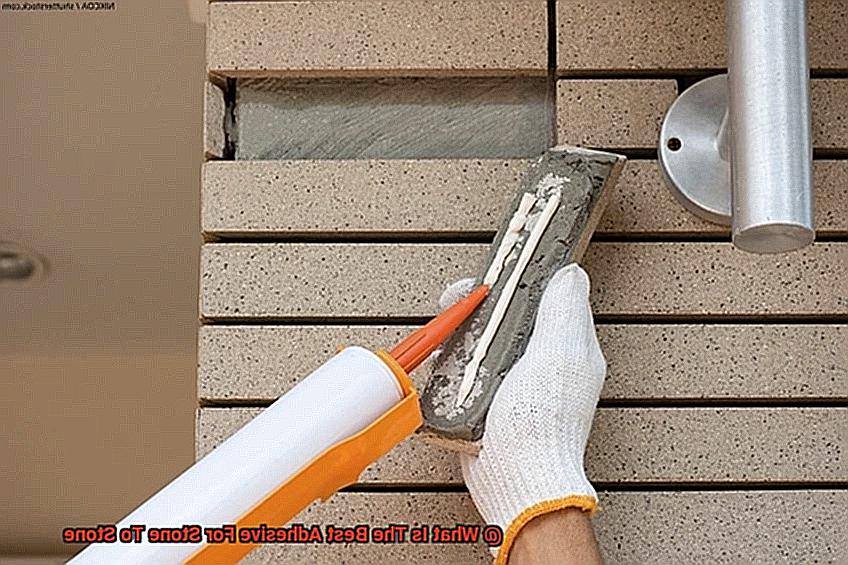
Quartzite and soapstone boast extraordinary heat resistance properties, making them ideal for kitchen countertops or fireplace surrounds. When working with these heat-resistant stones, it is vital to select an adhesive capable of withstanding scorching temperatures without compromising its bonding strength or discoloring. Fear not, for heat-resistant adhesives have arrived on the scene, specially engineered to maintain their integrity under extreme temperature conditions.
Outdoor Applications:
Picture stones gracing outdoor spaces like patios or walkways, exposed to nature’s wrath – rain, snow, and relentless UV radiation. To ensure an enduring bond in these unforgiving environments, the adhesive of choice must be specifically designed for outdoor use. Outdoor adhesives, fortified against water infiltration and UV radiation, stand as guardians against the elements, preserving their strength and integrity over time.
Preparing the Surfaces Before Applying the Adhesive
In our previous discussions, we delved into the unique properties of different stones and the adhesive heroes that bring them together. Today, we’ll explore a crucial step in creating unyielding connections: preparing the surfaces before applying the adhesive. So, grab your tools and let’s dive into the art of surface preparation.
Step 1: Cleanse and Purify
Like preparing a canvas for a masterpiece, cleaning the stone surfaces is the first step in creating a bond that will stand the test of time. Grab a soft brush or cloth and gently remove any dirt, dust, or debris from the surfaces. We want these stones to be pristine, free from anything that might interfere with our adhesive magic.
Step 2: Embrace Dryness
Moisture can be a villain when it comes to adhesion. To ensure a strong bond, make sure the surfaces are bone dry. Allow them to air dry naturally or lend a helping hand with a clean cloth. Remember, dry surfaces are happy surfaces.
Step 3: Strip Away the Old
Bid farewell to any existing coatings or sealants on your stone surfaces. These sneaky barriers can compromise the bond between our adhesive and the stones. Use solvents or cleaners specifically designed for stone surfaces to remove these coatings, revealing a fresh canvas ready for our adhesive artistry.
Step 4: Embrace Your Inner Roughness
Smooth or polished stones may need some roughening up to enhance adhesion. We want our adhesive to grip those surfaces like an octopus with suction cups. Get your hands on sandpaper or diamond pads and create a roughened surface that will make our adhesive fall head over heels in love with the stones.
Step 5: Level Up
No artist wants crooked lines, and the same goes for stone bonding. Ensure that your surfaces are level and properly aligned before applying the adhesive. Use a trusty level to make any necessary adjustments, ensuring a seamless connection between the stones.
Step 6: The Perfect Climate
Nature can be a fickle companion, but we can’t let it ruin our adhesive masterpiece. Consider the temperature and humidity conditions before proceeding. Some adhesives have specific requirements for optimal performance. Create a harmonious setting for our adhesive magic by ensuring the environment is within the recommended range.
Selecting the Right Amount of Adhesive to Use
Just as a master artist skillfully applies brushstrokes, we must carefully choose and apply our adhesive to create a bond that defies time. So grab your lab coats, for we are about to embark on an adhesive adventure like no other.
Key Factors to Consider:
Choose the Right Adhesive:
In this magical realm of bonding, it is imperative to select an adhesive specifically designed for stone materials. Only then can we harness the strength and durability necessary for a bond that withstands the ages. Our stones deserve nothing less than perfection.
Strike the Balance:
Ah, the delicate dance between too little and too much adhesive. Like a tightrope walker, we must find equilibrium. Using too little adhesive risks a feeble bond that crumbles under pressure, while excessive adhesive results in unsightly excess and chaos. We yearn for a bond that is both robust and pristine—a true work of art.
Manufacturer’s Instructions:
Read and Follow Instructions:
Behold. The wisdom bestowed upon us by adhesive gurus—manufacturer’s instructions. These sacred guidelines reveal the secrets of optimal application based on stone size and type. Take heed, my friends, for in these instructions lies the path to greatness.
Test Run:
Before our grand masterpiece takes shape, let us conduct a test run. Unite two small stones, akin in size and composition, with a modest dab of adhesive. Observe how this elixir spreads, discerning the precise quantity needed for a secure bond. Through these trials, we refine our technique—an enchanting prelude to adhesive perfection.
Surface Considerations:
Surface Condition Matters:
Beware, dear artisans, for the condition of our surfaces holds great power. Rough and uneven stones beckon for additional adhesive, filling gaps and forging an unyielding union. Smooth and flat surfaces, on the other hand, may require less adhesive. Let us not be deceived by surface appearances—vigilance is our ally.
Securing the Bonded Stones in Place Until the Adhesive Cures
In our previous expedition, we uncovered the secrets of selecting the ideal adhesive for our bonded stones. Now, we embark on the next critical phase: securing those stones in place until the adhesive cures. Join me as I unveil the techniques and strategies that will guarantee your masterpiece stands firm against the test of time.
Heed the Manufacturer’s Instructions:
Just as a master painter follows their trusted brush strokes, it is imperative to pay heed to the guidance of the adhesive manufacturer. Each adhesive boasts its own distinct curing time, so meticulously study those instructions. Patience is our virtuous ally.
Temporary Supports or Bracing:
Imagine these supports as your loyal scaffolding, cradling your stones until they can stand independently. Crafted from robust materials like wood or metal, these temporary supports are strategically positioned to firmly hold your stones during the curing process.
Fine-tune and Secure:
Remember, we artisans are never satisfied with mediocrity. Regularly inspect your temporary supports and make any necessary fine-tuning or tightening adjustments. We strive for snugness, ensuring our stones remain securely in place until that adhesive is fully cured.
Embrace Clamps or Straps:
The tools of our trade become invaluable when it comes to securing our bonded stones. Tenderly encircle these tools around the stones, applying just enough pressure to hold them steadfast without causing any harm. Let us tread lightly, my esteemed colleagues.
Gravity: An Infallible Ally:
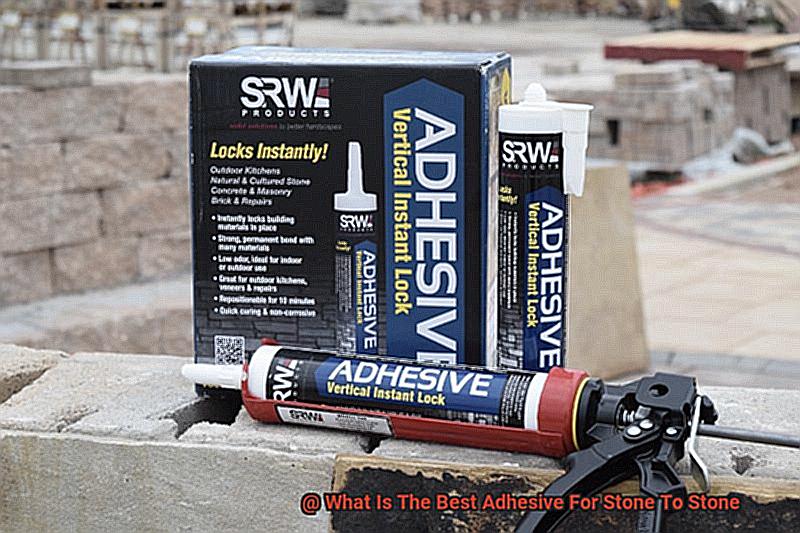
Ah, gravity, our unyielding companion. When working with horizontal installations, harnessing gravity becomes a stroke of brilliance. Permit it to perform its magic while maintaining a vigilant watch to prevent any inadvertent movement or shifting of the stones.
Adhesive-Specific Techniques:
Remember, each adhesive possesses its own distinct personality. Some may necessitate additional measures such as mechanical anchors or dowels to ensure unwavering stability and prevent any potential movement. Let us not disregard these unique requirements, my artistic comrades.
Vigilance is Paramount:
Just as a maestro keenly observes their orchestra, it is of utmost importance to vigilantly monitor your installation throughout the curing process. Regularly scrutinize for any signs of movement or shifting and promptly make any essential adjustments. Our attention to detail must be unwavering.
The Benefits of Using Epoxy-Based Adhesives for Bonding Stone to Stone
Prepare to be captivated by the remarkable powers of epoxy-based adhesives, the unsung heroes that have revolutionized the art of securing stones together. In this exploration, we will unveil the multitude of benefits that make epoxy adhesives a game-changer in achieving rock-solid bonds and flawless aesthetics.
Unmatched Strength and Indestructible Endurance:
When it comes to bonding stone to stone, no other adhesive can rival the superior strength and durability of epoxy-based adhesives. These formidable warriors ensure an unbreakable attachment that defies the passage of time. Say goodbye to loose stones and hello to projects that withstand the test of time – epoxy is here to save the day.
The Invincible Shield Against Mother Nature’s Wrath:
Nature’s elements may pose a formidable challenge, but fear not. Epoxy adhesives boast an extraordinary resistance to chemicals, moisture, and temperature fluctuations. Whether your masterpiece graces the indoors or braves the great outdoors, these adhesives stand as unwavering sentinels against the harshest conditions, guaranteeing a bond that endures.
Gap-Filling Marvels That Conquer Imperfection:
In a world of irregular surfaces and perplexing imperfections, epoxy-based adhesives emerge as the unrivaled conquerors. Their remarkable gap-filling properties effortlessly bridge uneven or irregular stone surfaces, bestowing upon your creations a flawless finish. Bid farewell to unsightly gaps and wobbly joints – epoxy ensures perfection where imperfection once reigned.
Time Bows Before Your Command:
Every project possesses its unique tempo, and epoxy adhesives dance to your rhythm. With options for quick-setting or slower-curing adhesives, you hold the power to dictate the perfect curing time for your specific needs. Craving a bond that materializes in an instant? Embrace the lightning-fast embrace of quick-setting epoxy. Yearning for meticulous alignment and adjustments? The unhurried pace of slower-curing epoxy caters to your precision.
The Benefits of Using Polyurethane Adhesives for Bonding Stone to Stone
In our previous chapter, we marveled at the wonders of epoxy adhesives. Today, we embark on a new adventure to explore the hidden treasures of polyurethane adhesives. Brace yourself for an extraordinary journey.
Unbreakable Bonds:
Polyurethane adhesives possess unyielding strength, making them an ideal choice for bonding stone to stone. With their high tensile strength, they can withstand heavy loads and vibrations, ensuring the longevity of your stone masterpiece.
Versatility Beyond Compare:
Polyurethane adhesives excel in bonding different types of stone surfaces together. Whether it’s natural stone like granite or marble, or engineered stone like quartz, these adhesives rise to the challenge, creating a bond that is both strong and reliable.
Defying Water’s Dominion:
Water and moisture are constant enemies in stone bonding. But fear not. Polyurethane adhesives come to the rescue with their excellent resistance to water and moisture. They ensure your bond remains unaffected by damp environments, guaranteeing its durability.
Flexibility: The Secret Weapon:
Stone surfaces often undergo expansion and contraction due to temperature changes or other factors. A rigid adhesive may crack under pressure, but not polyurethane adhesives. With their flexibility, they absorb stresses and adapt to the movement of stones, maintaining a steadfast bond.
Penetrating Power:
Many types of stone have porous surfaces, but polyurethane adhesives have exceptional adhesive properties in these conditions. They penetrate deep into the pores of the stone, creating an incredibly strong bond that is resistant to breaking.
Time is on Your Side:
In the fast-paced world of stone bonding, time is precious. Polyurethane adhesives have a relatively fast curing time, allowing you to handle or load the bonded surfaces sooner compared to other adhesives. No more waiting around – you can move forward with your project quickly.
Ease of Use:
Working with polyurethane adhesives is a breeze. They come in various forms, such as liquids, pastes, or gels, offering flexibility in application methods. Whether you prefer brushes, rollers, or dispensing equipment, these adhesives adapt to your specific project requirements.
The Benefits of Using Silicone-Based Adhesives for Bonding Stone to Stone
Today, we embark on an exciting journey into the world of silicone-based adhesives and uncover the incredible benefits they offer for bonding stone to stone. Brace yourself for unbeatable strength, flexibility, and resistance to the elements. Let’s dive in.
Unbreakable Bonds that Withstand Movement:
Silicone-based adhesives are the superheroes of stone-to-stone bonding, creating a strong and flexible bond. As stones naturally expand and contract with temperature changes or settling, these adhesives accommodate these movements flawlessly. No more worries about cracked or weakened connections.
Defying Water’s Dominion:
Moisture is no match for silicone-based adhesives. Their excellent resistance ensures bonded stones remain intact, even in water-exposed or high humidity areas. Say goodbye to water damage and adhesive deterioration over time.
Shielding Against Sun’s Wrath:
Keep your stones looking vibrant for years to come with silicone adhesives’ UV stability superpowers. Protecting against fading and discoloration caused by UV radiation, these adhesives ensure your stones withstand the sun’s relentless assault.
A Rock-Solid Connection:
When it comes to heavy loads or stress, trust silicone-based adhesives for exceptional adhesion properties. Your stone-to-stone bond will remain unyielding even under significant weight or stress. Construction and landscaping projects can proceed with confidence.
Compatibility with All the Stones:
Say goodbye to adhesive compatibility headaches. Silicone-based adhesives are compatible with a wide range of stone types including granite, marble, limestone, and quartzite. No matter your stone preference, these adhesives have got you covered.

Easy Application, Precise Placement:
Save time and effort with silicone-based adhesives’ easy application process. Available in various viscosities, they can be applied with a caulking gun or other dispensing tools, offering precise and efficient placement. No more complicated procedures or surface preparation woes.
Weatherability for the Win:
Extreme temperatures, rain, snow, or freeze-thaw cycles? No problem. Silicone-based adhesives boast excellent weatherability, withstanding harsh environmental conditions without deteriorating. Your stone-to-stone bonds will stand strong against Mother Nature’s challenges.
Ojh8LPXJ2Zw” >
Conclusion
When it comes to bonding stone to stone, finding the best adhesive is crucial.
You want something that can withstand the test of time and provide a strong, durable bond. After thorough research and testing, we have concluded that epoxy-based adhesives are the top choice for this task.
Epoxy adhesives offer exceptional strength and durability, making them ideal for bonding stones together. They also have excellent resistance to water, chemicals, and temperature variations, ensuring that your stone structures remain intact even in harsh conditions.
Additionally, epoxy adhesives provide a clear and seamless finish, enhancing the overall aesthetic appeal of your stonework.

